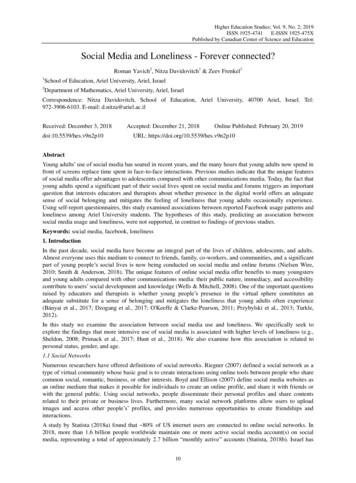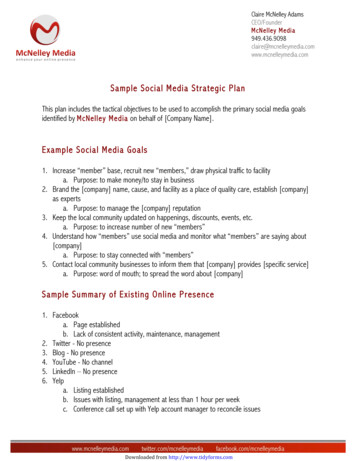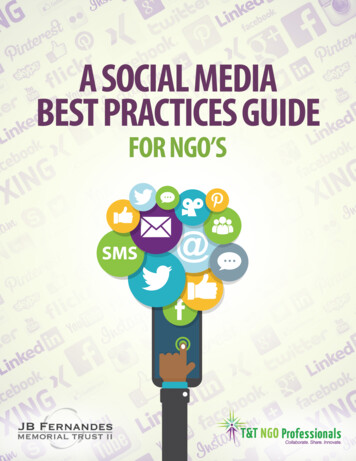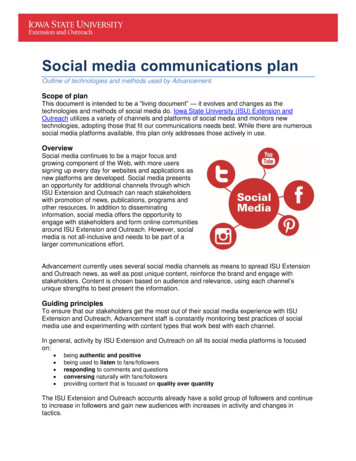
Transcription
The Fundamentals ofSocial Media Analytics
Table of ContentsIntroduction3Part 1: What is Social Media Analytics?4Social Media Analytics vs. Social Media Monitoring vs. SocialMedia Intelligence6Understanding Unsolicited Conversations8Social Media Engagement9Part 2: Dealing with Unstructured Data10Defining Unstructured Data11Machine-Automated NLP and Machine-Learning13Part 3: Deriving Insights from Social Metrics18Quantitative Analysis: The What20Qualitative Analysis: The Why21In Summary242
IntroductionSocial media has completely transformed the way people interact with each other, but it’s hadan equally significant (though more easily overlooked) impact on businesses as well. There arenow billions of unsolicited posts directly from consumers that brands, agencies and otherorganizations can use to better understand their target customer, industry landscape orbrand perception.In light of all this data, we come to a natural question: How can marketers, strategists,executives and analysts make sense of it all? What tools and resources are there outthere to help?Crimson Hexagon has been analyzing social data since 2007, and we’ve learned a lot during thattime about how to approach, understand, and leverage social media data.This guide aims to provide a framework for this discussion. Whether you’re a CMO, an analyst, ora Category Director, this guide will help you learn the fundamentals of social media analytics andhow you can apply it to your organization to make smarter, more data-backed decisions.
Part One: What is SocialMedia Analytics?
Part One: What is Social Media Analytics?Social media platforms—such as Facebook, Twitter, Instagram,and Tumblr—are a public ‘worldwide forum for expression’, wherebillions of people connect and share their experiences, personalviews, and opinions about everything from vacations to live events.But social media isn’t just a place for individuals to connect witheach other. It’s also a place for brands and customers to interact.The growth of these platforms has provided companies a newsource of insights on which to base their strategies: socialconversations. Through social media analytics, businesses havethe opportunity to listen, monitor, and look in depth at theseconversations and understand what people are saying onlineto make better-informed decisions.5
Social Media Analytics vs. Social MediaMonitoring vs. Social Media IntelligenceWithin organizations, different people and departments haveunique research questions, therefore their reasons for analyzingsocial media platforms and leveraging social insights differ.Some of the use cases include:Whether you are knowledgeable of these terms or not,you’ve probably heard the term ‘social media analytics’ usedinterchangeably with ‘social media listening’ and ‘social mediaintelligence’, but they aren’t exactly the same. First, we’ll beginby approaching the term ‘Social Media Analytics’.Brand positioning assessment: What are people saying aboutmy brand?Competitive research: How is my competitor doing? What arepeople saying about their product?The Definition of ‘Social Media Analytics’Campaign planning and measurement: Was the new campaigneffective? What was the conversation around the campaign?Of all the definitions for ‘Social Media Analytics’, Gohfar F. Khan’shit the nail on the head. In his Seven Layers of Social Media book,he defined social media analytics as “the art and science ofextracting valuable hidden insights from vast amounts ofsemistructured and unstructured social media data toenable informed and insightful decision making”.Audience interest and demographic understanding: Who isinterested in my product? What are their interests?Industry and product trend discovery: What are popular trendsat the moment?Performance benchmarking: How is my product positionedcompared to my competitor’s?Early warning – crisis management: What issues can beidentified? How can it be fixed?Many organizations don’t listen to social conversations becauseof the overwhelming amount of available data; however, thereare certain tools that specialize in capturing and interpreting thisconversation online, making it easier to separate valuable signalsfrom social media noise. These tools can crawl most social mediachannels, including anything from the main social networks toforums, news sites, and blogs.6
Social Media Monitoring (SMM)Social Media Intelligence (SMI)Often referred as ‘social media listening’, social media monitoringis the ongoing process of tracking and gathering what theaudience is saying on social media—a hashtag, a keyword, orother terms—about a brand or its competitors.Social media intelligence encompasses monitoring socialmedia, collecting and analyzing the content, and using theresulting insights to inform strategy. Basically, SMI uses bothsocial media monitoring and analytics to derive strategic solutions.As stated in The Future Place, monitoring can be active, such assearching for specific brand mentions, or passive, like tuning intoan audience to learn about their interests.Think of McDonald’s new campaign introducing theirpreservative-free chicken nuggets. Both McDonald’s and theagency responsible for their ad “A Better Chicken McNugget”would rely on SMM to track surface-level metrics to measuretheir new campaign. These vanity metrics, such as numberof likes, shares, or retweets would be used to assess basicengagement and campaign performance, without lookingfor deep understanding of the social conversation aroundMcNuggets and its context.As a summary, SMM consists of identifying and collecting usefuldata, with no means of categorizing or understanding it. The datagathered through SMM could be useful, but no insights can bederived at this listening stage.Source: McDonalds7
Understanding Unsolicited ConversationsSocial media analytics is an exercise in omniscience, notomnipotence. Before we begin drilling into why this is soimportant, here are the definitions for both:Omniscience: knowing everything; having unlimited understanding or knowledgeOmnipotence: having complete or unlimited powerSocial media is a place where users can talk freely without havingto filter themselves. This is why SMA is omniscient and notomnipotent: it knows everything about a certain topic, but doesn’tneed to participate or control these social conversations. Whatwe mean when we say “omniscient SMA”, we refer to the analysisof unsolicited conversations on social media, without the intentof interfering or asking them to be part of a two-way conversation. Social media analytics is used to observe and inform, notto engage.“Superman is too busy saving the world, soBatman needs to focus on street level crime.”The ArtificeThink of it this way: Batman is omniscient and Superman isomnipotent. Although most organizations want to assimilatethemselves to a God-like character with unlimited power likeSuperman, Batman is more intelligent, relatable and versatilein his job.Photo Credit: WarnerBrosOrganizations can’t control the social conversation becausesocial conversations around brands on social media arelargely unsolicited.Unlike traditional focus groups, social media analysis extractsinsights from unsolicited conversations without the added bias ofdirect contact. By listening and understanding from an outsideperspective without trying to be part of the conversation, you geta more objective perspective.8
Social Media Analytics vs. Social MediaEngagementTherefore, social media analysis and social media engagementare not the same. Ultimately, social media analysis is aboutlistening, whereas social media engagement is joining theconversation.Social media engagement involves a two-way conversation;with engagement, there’s a ‘personal’ interaction between brandsand their fans. Examples of social media engagement includeinteractions with customers, prospects, and influencers onsocial networks. When engaging with customers, brands canreach out to customers to remediate any issues they might havefound through social monitoring.Even if brands know how social media analysis works, whereshould they start? Next, we’ll explain how brands can usesocial media analytics to make sense of the vast amount ofunstructured data on social networks, and eventually use itto their advantage.Photo Credit: UXDesign9
Part Two: Dealing withUnstructured Data
Part Two: Dealing with Unstructured DataWhat is Structured Data?Unstructured data lacks organization. Due to its variability andunidentifiable internal structure, unstructured data cannot beanalyzed by the conventional technologies.With the explosion of big data, there has been a reciprocalexplosion of companies trying to mine value from theoverwhelming amount of data out there. When looking at thedata that needs to be analyzed, we can find two distinct types:structured and unstructured data.A few examples of ‘unstructured data’ are:We are all aware of structured data: purchases, transactionsand electronic sign-ups, but what is unstructured data? How isit different from structured data? Social media posts Emails Images Product ReviewsWhen looking at social media posts, we see that most of theinformation can’t be segmented into fixed categories due to thecomplexity and variability of the content. Social media users writeabout different subjects, in varying forms, making it hard tocategorize them in a strict manner. Due to the increase inpopularity of social media channels, new analytics tools andprocesses were developed to understand and extract value fromthis boom of unstructured data.Structured data refers to the kind of data that is organizedand displayed in a database with rows and columns, making itstraightforward to work with. Examples of this include salesfigures, names, phone numbers, and pretty much anything thatcan be categorized.Structured Data (Enterprise)Unstructured Data (Social Media)Photo Credit: The Executive's Guide to Big Data & Apache HadoopPhoto Credit: The Executive's Guide to Big Data & Apache Hadoop11
But why bother to extract this unstructured data?It can yield deeper insights.Organizations in several industries are researching and investing in tools to extractmeaning from this data and drive strategic business decisions, something hard to getfrom limited structured data. The value of unstructured data comes from the patternsand the meanings that can be derived from it. Examples include identifying issues,market trends, or overall customer sentiment towards a brand.Two available solutions for the analysis of unstructured data are machine-automatedNLP (natural language processing) and machine-learning.?12
Machine-Automated Natural Language Processing (NLP) and Machine-LearningApplications of NLP on social data can identify general sentimentabout a topic—either positive, neutral or negative—or it caneven go as far as analyzing the universal emotions throughemotion analysis.Natural Language Processing is a branch of artificial intelligencethat allows a machine to understand the human ‘natural’language. Therefore, the machine-automated solution tries tomake sense of the data by processing statements andcategorizing them in a systematic way.Back to School Emotions: Volume of Posts (Emotion) from 8/4/16 to 8/24/1650k40kPosts30k20k10k45Aug 20166Joy (261,068)78910Sadness (202,725)111213Disgust (10,098)1314151617Anger (36,578)181920Surprise (245)212223Fear (49,275)
Machine-automated SolutionsAren't EnoughMost analytics companies offer machine-automated features,but the problem is that the results can be inaccurate and notpertinent to the subject matter. Although machine automationrequires less setup time, it risks providing irrelevant informationto the user when analyzing conversations in different industrieswith particular dialects and slangs.An example where a dialect or slang could be a problem is whena word such as ‘wicked’ is used in different contexts. Meaning “evilor morally wrong”, ‘wicked’ is widely identified as a word with anegative connotation, thus machine-automated processes wouldnegatively categorize phrases with this word. However, ‘wicked’has a different meaning in the state of Massachusetts; used asa positive word, it can mean “very” or “occasionally cool”, makingthe outcome of the analysis very inaccurate and irrelevant to thesearch.wicked(but not in a bad way)14
On the other hand, for more comprehensive text analytics, there’s Or even better, think of machine-learning as a Gmail filter.Fundamentally, filtering in Gmail is adding a label or tag to emails,the machine-learning approach.so that it can count and group emails of the same kind together.To better understand this concept, think of the onlineIf properly trained, Gmail’s Inbox classifies emails into Topics likerecommendations from Amazon; depending on your purchases,Social/Promotions/Updates etc. This model looks for patterns insearch history, your ratings, Wish List, the interests of otherthe content of every email—such as keywords, phrases,similar customers, and more examples of what you’re interestedauthors—and assigns it to the most pertinent category; it doesn’tin, it will try to find items more relevant to your search.follow pre-defined parameters.Machine-learning allows tools to analyze multiple variablessimultaneously, and reveal how they interconnect toform patterns.This option differs from machine-automated solutions in manyways; since the outcome will be more related to the question theuser is trying to solve, machine-learning requires externalknowledge and deep understanding of the conversation’s subjectmatter to train the tools appropriately. Although training someposts to define each custom category may take some time, it willhelp the analysis tools to identify robust patterns and providemore relevant insights to the business question.Photo Credit: Madmimi15
Machine-Automated Approach: T-Mobile ExampleIt’s useful to know whether customer service was overall positiveor negative, but how can you extract more valuable, relevantinsights from this data? How can you know why big part of theconversation is negative? This is where machine-learningcomes in.In the following example, we can see the analysis of T-Mobile’scustomer service on Twitter in 2015. Through machine-learningNLP, social posts can be categorized into general positive, neutral,and negative sentiment by identifying the keywords.Buzz Copy of T-Mobile Support: Volume of Posts (Basic Sentiment) from 1/1/15 to 12/31/1515kPosts10k5k4Feb 2015Basic Positive (46,669)4Apr 2015Basic Neutral (94,107)Jun 2015Basic Negative (86, 586)16Aug 2015Oct 2015
Machine-Learning Approach: T-Mobile Exampleactionable solutions you can apply. Whether it is expensive plans,bad coverage, or insufficient customer service, organizations likeT-Mobile can use machine-learning to understand the ‘why’behind the negative sentiment towards their brand and makebetter informed decisions in the future.The following visual contains the same data and timeframeused to analyze T-Mobile’s basic sentiment around its customerservice. The main difference is that through machine-learning,you can create custom categories that will explain the reasonbehind the positive, neutral and negative sentiment, providingT-Mobile Support: Volume of Posts (Opinion and Analysis) from 1/1/15 to 12/31/1510k9k8kPosts7k6k5k4k3k2k1k44Feb 2015Apr 2015Jun 2015Aug 2015Oct 2015Positive: Customer Service/Thank You (15,658)Neutral: Network/Coverage (17,004)Negative: Customer Service (13,055)Positive: General Positive (6,238)Neutral: General Neutral (25,517)Negative: Devices/Shipping (25,240)Neutral: Plans/Pricing (14,240)Negative: General Negative (18,133)Negative: Plans/Pricing (17,074)Neutral: Devices (20,942)Negative: Network/Coverage (31,998)Custom categories in machine-learning processes allow the analysis to be more accurate and precise; someadvantages include deeper nuance and meaning dependent on the user’s subject matter expertise andbusiness context. With this solution, users can uncover insights to help them make more strategic decisions.17
Part Three: Deriving Insightsfrom Social Metrics
Part Three: Deriving Insights from Social MetricsIn marketing, strategy, and tech, we hear a lot of jargon around‘measurement’ and the ‘software landscape’. ‘Insights’ havebecome ubiquitous, with many organizations and individualsusing this term in many different ways.In previous publications, we’ve described how insights come inmany different forms. What are customers saying about yourproducts and company? How about your competition? Who isyour target market, what do they care about, and how do youreach them effectively? What trends are affecting your industryand how should you respond? These are relevant questions tothe decision-making of businesses, and they can be answeredthrough social media analytics. First, we will go over thedifference between quantitative and qualitative analysis tobetter understand how you can derive insights fromsocial data.19
Quantitative Analysis: The WhatSimilar to the infamous McNamara Fallacy, this analysis supportsthe theory that “If you can’t measure it, it doesn’t exist” because itcan’t be proven. Therefore, in quantitative analysis, the only datataken into account for strategic decision-making is the data youcan count.This type of analysis is efficient and easy to gather and analyzebecause of its simplicity and concrete nature. Since it doesn’tdeal with complex data, it is more easily comprehended, andtherefore, more ‘credible’ than insights gained from qualitativeresearch, as it provides numerical proof.Consequently, quantitative analysis disregards data that isn’t inthe form of easily digestible numbers; therefore, if you can onlyunderstand a fraction of the available information, it isn’tcomprehensive or insightful enough. In social media, if yourFacebook campaign post has 1,000 likes, you get to know its“weight”. However, the 1000 likes don't necessarily meanthat the campaign was successful. From the perspective of sociallistening, it is important to understand the context and nuance;it is critical to understand the underlying ‘why’ of the 1,000 likes tosee if it’s something that the company wants to do again inthe future.20
Qualitative Analysis: The WhyQualitative analysis is less related to hard numbers, and moreto the meaning behind those numbers. So why did yourcompany get 1,000 likes? Did they like the product? Or was it themessage? What about the athlete that was sponsored? Theseintangibles provide knowledge and insights that can help drivemore effective and strategic solutions.21
their audience and compare this to those of their competitors.Knowing this information about their audience allowed JALCto carry on more informed campaigns and promotecustomer intimacy.In a presentation about The Power of Social Data with Schiresonconsultancy, Jazz at Lincoln Center (JALC) was able to gainvaluable insights about their audience. In the following visual,we see how JALC was able to understand the main interests of22
For the most comprehensive solution, a combination of both volumetrics andinsights is ideal.insights, businesses can discern what’s happening in social andwhy. Although all these insights can be derived from metrics, notall metrics can be insights.Although it is harder to work with qualitative data, it is necessaryto make sense of it since it provides deeper insights, as well asnuance and perspective that would be impossible to get frommere volumetrics. The results can give an understanding of thestory behind the results of the analysis of quantitative data. Forexample, with qualitative data, you can find popular trends oreven emotional sentiment around brands.Understanding the basics of social media analytics is the first stepto obtaining social media insights of strategic importance toorganizations. As the data analytics industry grows throughouttime, possessing basic knowledge about this topic will help youfind the optimal solutions to social data analysis.Volumetrics only touch the surface of understanding; they are anumerical indication of user reaction, but if complemented with23
In SummaryHere at Crimson Hexagon, we understand that social media analytics can be daunting forthose entering the field. The scope and volume of data from social may seem too large and toounactionable. But, with the right tools, it can provide key insights and inform big decisions.This guide was created to help you understand what social media analytics entails. We started byoutlining the different elements in social media analytics and clearing up general misconceptions.We then identified and described the types of data available. And, most importantly, we looked ateffective data analytics solutions to gather deeper insights.We live and work in a world that is hyper connected. We have the ability to communicate, engage,and collaborate with people, organizations and brands by a few simple clicks. Companies andorganizations have the opportunity to tune into the conversation, learn about their audiences,and enter the market better-informed.
Make better business decisions withcustomized social insights.
Social Media Analytics vs. Social Media Monitoring vs. Social Media Intelligence Whether you are knowledgeable of these terms or not, you’ve probably heard the term ‘social media analytics’ used interchangeably with ‘social media listening’ and ‘social media intelligen










